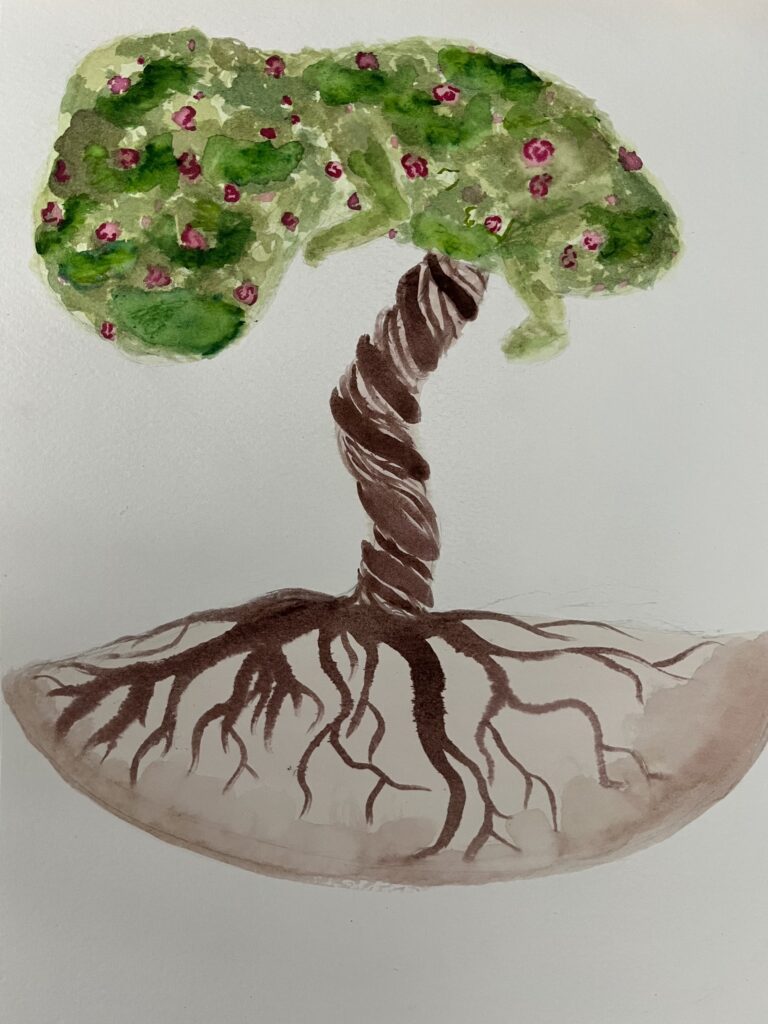
The objective that I am covering and looking beyond is “placental formation and function.” My piece portrays the similarities between of the placenta’s role in providing nutrients to a growing fetus to that of how roots of a tree collect nutrients from the soil and provide it to the growing tree. The soil represents the placenta, the roots represent the vessels embedded into the placenta, the trunk represents the umbilical cord, and the tree canopy represents the fetus.
Created only during and for pregnancy, the placenta is the only disposable organ, expelled shortly after the baby is born. Acting as the liver, lungs, kidneys and gut of a fetus for the duration of their gestation, the placenta is arguably one of the most multifaceted organs in the body (Burton et al., 2015). One of the most important factors in fetal growth is the ability to obtain nutrients from the placenta. Nutrients are passed from the mother’s blood to the growing fetus via the umbilical cord. The umbilical vein runs directly from the placenta, towards the baby’s liver, and into the inferior vena cava so that the nutrients and oxygenated blood supplied from the mother can be circulated and absorbed within the baby to allow for growth (Freeborn et al).
Sometimes there is a random defect in placental transport functions which hinders the amount of nutrients passed to the fetus. This defect can lead to intrauterine growth restriction, or IUGR (Cetin et al). This is a condition that can affect both placental metabolism and transport which restricts the fetus from growing and developing properly. While the spontaneous cause of placental malfunction is widely unknown, some risk factors include placental abruption, placenta previa, infection in the tissues surrounding the fetus, and maternal health and nutrition (Weiss, 2022). Because the placenta’s function includes passing nutrients directly to the mother to fetus, maternal diet and health is a large factor in preventing IUGR. Studies have shown that smoking along with use of drugs and alcohol and certain medications can lead to IUGR. Smoking leads to increased levels of carbon monoxide crossing the placenta causing reduced oxygen to the tissues of the fetus due to oxygen displacement from hemoglobin. Studies have also shown that heavy alcohol and recreational drug use leads to a significantly higher risk of the condition (Odendaal et al, 2020).
IUGR can be detected when the uterine fundal height is checked or during a prenatal ultrasound. Once diagnosed, the baby’s growth is closely monitored and depending on the stage of pregnancy, treatment can look different. The mother’s diet is sometimes altered or is placed on bed rest to improve blood flow to the baby. Some babies affected by IUGR are delivered at an earlier gestational age (typically after 34 weeks, but earlier as necessary) in the case of placental malfunction in order to avoid the placenta failing altogether or to supplement nutrients to avoid neonatal mortality and morbidity (Hirsch, 2020). The biggest risk factor of IUGR is a low birth weight which has proven to result in greater issues including reduced lung function, brain bleed, jaundice, and infection. The best ways to prevent IUGR are for the mother to maintain a healthy diet and avoid drug use, certain medications, and alcohol. Monitoring of IUGR is crucial in preventing neonatal mortality and morbidity (Weiss, 2022).
Citations
Burton, G. J., & Juaniaux, E. (2015, September 29). What is the placenta? American Journal of Obstetrics and Gynecology. Retrieved April 10, 2023, from https://www.sciencedirect.com/science/article/abs/pii/S0002937815008510
Freeborn, D., Trevino, H., & Adler, L. (n.d.). Blood circulation in the fetus and newborn. Blood Circulation in the Fetus and Newborn – Health Encyclopedia – University of Rochester Medical Center. Retrieved April 12, 2023, from https://www.urmc.rochester.edu/encyclopedia/content.aspx?ContentTypeID=90&ContentID=P02362
Cetin, I., & Alvino, G. (2009, January 13). Intrauterine growth restriction: Implications for placental metabolism and transport. A Review. Placenta. Retrieved April 20, 2023, from https://www.sciencedirect.com/science/article/abs/pii/S0143400408004190
Weiss, R. E. (2022, September 21). Intrauterine growth restriction causes, prevention, and risks. Verywell Family. Retrieved April 20, 2023, from https://www.verywellfamily.com/intrauterine-growth-restriction-iugr-2758985
Odendaal, H. J., Kruger, M., & Botha, M. H. (2020, October 28). Dangers of smoking cigarettes and drinking alcohol during pregnancy. South African medical journal = Suid-Afrikaanse tydskrif vir geneeskunde. Retrieved April 20, 2023, from https://www.ncbi.nlm.nih.gov/pmc/articles/PMC8011951/
Hirsch, L. (Ed.). (2020, July). Intrauterine growth restriction (IUGR) (for parents). KidsHealth. Retrieved April 20, 2023, from https://kidshealth.org/en/parents/iugr.html

I really like the concept of the placenta as the tree of life. It is so true that the placenta provides life to the fetus. Just as the tree can not thrive and give fruit with out the roots. The fetus can not grow and become a baby with out the placenta. You showed this very well through this nicely done water color. You met your objective of “placental formation and function” well. I liked how you pointed out that the placenta is the only disposable organ and it is multifunctional acting as the liver, lungs, kidneys and gut of the fetus. Not to mention the importance of providing nutrients to the fetus just like the roots provide nutrients to the tree. And the umbilical cord just like the trunk of the tree allows interchange from the fetus to the placenta and the roots to the canopy. It was also interesting to learn about intrauterine growth restriction (IUGR) and how it effects the placenta. It is a good reminder why it is so important to have good prenatal health care and refrain from the use of tobacco, alcohol and drugs when you are pregnant. You also point out the importance of a good diet during pregnancy just as the tree needs good soil to grow, the mother has to have a good diet so that there are nutrients available for the use of the fetus. Over all great job!